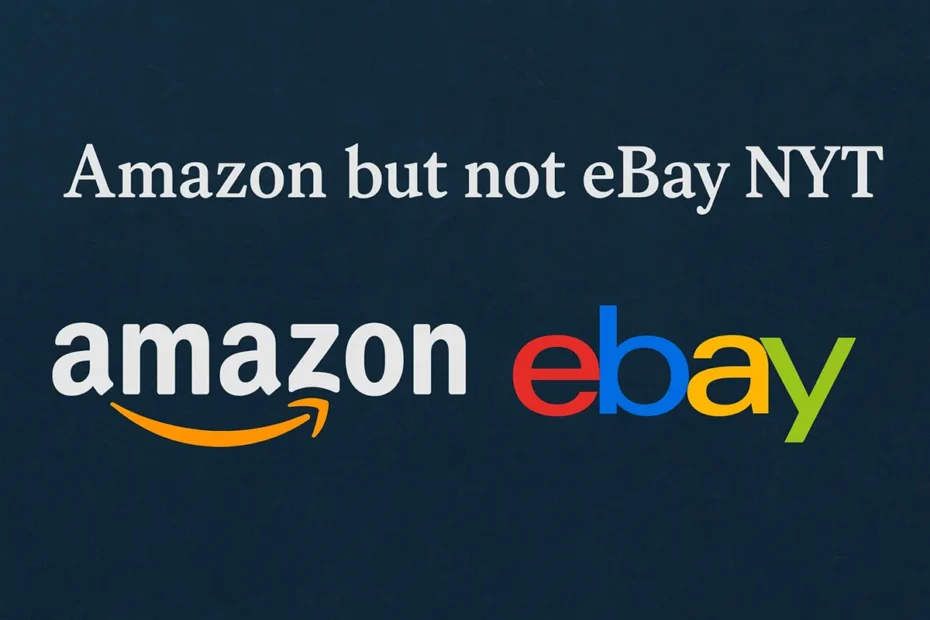In recent years, the retail landscape has experienced a dramatic shift, and Amazon but not eBay NYT has become a focal point for industry analysts and consumers alike. While eBay revolutionized online auctions and peer-to-peer sales, Amazon has consistently evolved into a dominant marketplace, redefining convenience, technology, and consumer expectations. The New York Times (NYT) has frequently reported on this phenomenon, highlighting how Amazon’s innovative strategies have set it apart from competitors like eBay.
Amazon’s Unique Business Model
One of the key reasons for Amazon’s success, as reported in Amazon but not the NYT, is its diversified business model. Unlike eBay, which primarily focuses on facilitating transactions between individual sellers and buyers, Amazon controls every aspect of its marketplace. From inventory management to shipping logistics, Amazon ensures a seamless customer experience. This comprehensive approach has not only built trust among consumers but also generated consistent revenue streams that eBay struggles to match.
Amazon’s subscription services, like Amazon Prime, further differentiate it from eBay. Amazon but not eBay NYT coverage emphasizes how Prime membership creates a loyal customer base by offering benefits such as free shipping, exclusive deals, and streaming services. By integrating entertainment, retail, and technology, Amazon has crafted an ecosystem that keeps users engaged beyond traditional shopping.
Technological Innovation
Another factor highlighted by amazon but not eBay NYT is Amazon’s commitment to technological innovation. Amazon invests heavily in AI, machine learning, and robotics to optimize its operations. This allows for faster delivery, smarter recommendations, and efficient warehouse management. eBay, on the other hand, primarily relies on its users to manage listings, pricing, and shipping, which can result in inconsistencies and slower service.
Additionally, Amazon’s Alexa and voice commerce innovations demonstrate how the company continually explores new ways to capture consumer attention. While eBay has experimented with mobile apps and social selling, it lacks the technological depth that Amazon showcases across multiple sectors, further emphasizing the gap between the two platforms.
Market Dominance and Consumer Perception
Consumer perception is a vital aspect of Amazon’s success, as noted in the Amazon but not eBay NYT articles. Amazon is often perceived as a reliable, one-stop shop for millions of products. Its user-friendly interface, transparent reviews, and competitive pricing contribute to an overall superior shopping experience. eBay, though still popular for collectibles and niche items, struggles to maintain the same level of mainstream credibility.
The NYT has also highlighted Amazon’s global expansion strategy. With marketplaces in multiple countries and localized services, Amazon can tap into international demand efficiently. eBay operates globally as well, but it has a fragmented approach that limits scalability in comparison to Amazon’s cohesive operational model.
Economic and Social Impacts
The discussion of Amazon but not eBay NYT is not just about commerce; it also touches on broader economic and social implications. Amazon’s rise has reshaped employment, logistics, and even urban development. Its fulfillment centers have created thousands of jobs, though not without controversy regarding labor practices. eBay’s decentralized model does not produce the same widespread economic footprint, which highlights Amazon’s unique influence on both local and global economies.
Moreover, Amazon’s influence on consumer behavior is profound. The convenience of same-day delivery and personalized recommendations has conditioned shoppers to expect more from e-commerce. Analysts cited in Amazon but not eBay NYT suggest that these shifts are likely to continue, reinforcing Amazon’s position as a trendsetter in the industry.
Challenges and Criticisms
Despite its dominance, Amazon faces criticism and challenges, which the New York Times has extensively covered. Issues such as antitrust concerns, environmental impact, and labor practices have sparked public debates. However, even with these hurdles, Amazon continues to outperform eBay in terms of revenue, customer satisfaction, and innovation, demonstrating resilience and adaptability in a rapidly changing market.
eBay, while maintaining a niche audience, has struggled to innovate at the same pace. The platform remains heavily dependent on user-generated content, which limits its ability to scale operations or provide a fully controlled shopping experience comparable to Amazon. This distinction reinforces the insight captured by Amazon but not eBay NYT coverage: Amazon thrives where eBay has plateaued.
Conclusion
In conclusion, the story of Amazon but not eBay NYT illustrates the transformation of e-commerce over the past two decades. Amazon’s holistic business approach, technological innovation, and market dominance clearly set it apart from eBay. Through strategic expansions, customer-focused services, and continuous innovation, Amazon has not only reshaped online shopping but also influenced global economic patterns.
As consumers continue to demand faster, smarter, and more convenient shopping experiences, Amazon’s trajectory is likely to remain robust. Meanwhile, eBay will continue serving niche markets but may struggle to achieve the same mainstream prominence. For those seeking insights into modern retail dynamics, the coverage of Amazon but not eBay NYT in the NYT offers a comprehensive view of why Amazon stands alone at the forefront of e-commerce innovation.
FAQs:
1. What does “Amazon but not eBay NYT” mean?
It refers to discussions and coverage in the New York Times comparing Amazon’s growth and strategies with eBay’s, highlighting why Amazon dominates.
2. Why is Amazon more successful than eBay?
Amazon’s success comes from its full control over logistics, subscription services, technological innovations, and a seamless customer experience.
3. Does the NYT cover both Amazon and eBay?
Yes, the NYT frequently analyzes both companies, but coverage often emphasizes Amazon’s rapid growth and industry influence.
4. How has Amazon changed online shopping compared to eBay?
Amazon offers faster delivery, personalized recommendations, and a one-stop shop experience, while eBay focuses on auctions and niche products.
5. Is eBay still relevant in e-commerce?
Yes, eBay remains popular for collectibles, second-hand goods, and auctions, but it hasn’t matched Amazon’s mainstream dominance.
